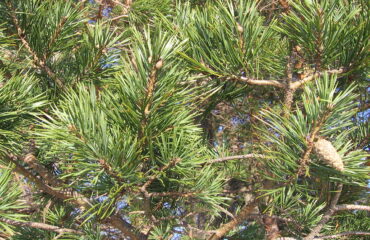Picea, commonly known as Spruce, is a genus of evergreen coniferous trees in the Pinaceae family, native to the temperate and boreal regions of the Northern Hemisphere. Spruce trees are valued for their symmetrical, conical shape, dense foliage, and their use in forestry, landscaping, and as Christmas trees. The needles are short, stiff, and four-sided, attached individually to the branches, and vary in color from deep green to blue-green or even silvery-gray. The cones are cylindrical and hang downwards, adding ornamental value. Popular species include Picea abies (Norway Spruce), Picea glauca (White Spruce), Picea pungens (Colorado Blue Spruce), and Picea omorika (Serbian Spruce). Spruce trees typically grow to a height of 60-200 feet (18-60 meters) and a spread of 15-35 feet (4.5-10.5 meters), depending on the species and growing conditions. Due to their height, they are often used as windbreaks, specimen trees, and in reforestation projects.
Preferred Growing Conditions:
- Soil Type: Prefers well-drained, slightly acidic to neutral soil; thrives in a mix of loamy or sandy soils enriched with organic matter. Can tolerate a range of soil types but does not perform well in heavy clay or waterlogged soils.
- Sunlight: Grows best in full sun; requires at least 6 hours of direct sunlight daily for optimal growth and foliage color. Can tolerate partial shade but may become less dense.
- Temperature: Hardy in USDA zones 2-7 depending on the species; tolerates cold winters and prefers temperate to cool climates. Some species are more cold-hardy and can withstand severe frosts.
- Water Needs: Moderate; requires regular watering during dry periods, especially when young, but is relatively drought-tolerant once established. Avoid prolonged drought stress to prevent needle drop.
Picea (Spruce) Propagation Methods:
1. Seed Propagation:
Growing Picea from seeds is a traditional and effective method that allows for the natural genetic diversity and production of robust trees.
- Seed Collection and Preparation:
- Collect seeds from mature cones in late summer to early autumn once they have turned brown and begun to open.
- Extract the seeds from the cones and remove the surrounding wing.
- Seeds benefit from stratification. Place seeds in a moist medium (such as sand or peat moss) and refrigerate at around 35-40°F (1.5-4°C) for 1-3 months to break dormancy.
- Sowing Techniques:
- After stratification, sow seeds in seed trays or small pots filled with a light, well-draining seed-starting mix.
- Sow the seeds on the surface and cover lightly with a thin layer of soil or sand.
- Keep the soil consistently moist but not waterlogged.
- Place the trays in a bright location with temperatures around 65-75°F (18-24°C).
- Germination Requirements:
- Seeds typically germinate within 2-4 weeks under optimal conditions, but some species may take longer.
- Once seedlings emerge, provide bright, indirect light and maintain consistent moisture.
- When seedlings have developed several true leaves and are sturdy enough to handle, transplant them into individual pots.
2. Stem Cuttings:
Propagating Picea from stem cuttings can be challenging but is used for cloning specific cultivars or maintaining the traits of a particular tree.
- Types of Cuttings:
- Use semi-hardwood cuttings taken in late summer to early autumn or hardwood cuttings taken in late autumn to early winter when the plant is not actively growing.
- Preparation:
- Select healthy, non-flowering shoots and cut 4-6 inch sections just below a node.
- Remove the lower needles, leaving only the top few pairs of needles on the cutting.
- Optionally, dip the cut end in rooting hormone to encourage faster rooting.
- Planting:
- Insert the cuttings into a well-draining potting mix, such as a blend of peat and perlite or a commercial rooting mix.
- Water lightly to settle the soil and place the pot in a bright, indirect light location.
- Cover the pot with a plastic bag or place in a propagation tray with a clear lid to maintain high humidity.
- Rooting:
- Roots should begin to form within 8-12 weeks, though rooting can be slow and variable.
- Once roots are established and new growth appears, gradually acclimate the cuttings to lower humidity.
- Transplant the rooted cuttings into individual pots or directly into the garden.
3. Grafting:
Grafting is often used for propagating Picea, especially for maintaining the characteristics of specific cultivars or producing uniform nursery stock.
- Types of Grafting:
- Side veneer grafting or whip-and-tongue grafting are commonly used for Spruce.
- Preparation:
- Select a healthy rootstock and a compatible scion from the desired cultivar.
- The scion should be a young, dormant shoot with several buds.
- Process:
- Make a clean cut on both the rootstock and the scion, creating matching cuts for the chosen grafting method.
- Align the cuts so that the cambium layers of both parts are in contact.
- Secure the graft with grafting tape or rubber bands and seal with grafting wax to prevent drying out.
- Place the grafted plant in a cool, shaded area until the union is secure and new growth begins.
- Care for Grafted Plants:
- Once the graft has taken and new growth appears, gradually acclimate the plant to outdoor conditions.
- Provide regular watering and protect from strong winds and harsh sunlight.
4. Air Layering:
Air layering can be used to propagate Picea, particularly for mature branches that can be induced to root while still attached to the parent plant.
- Timing:
- Best done in spring or early summer when the plant is actively growing.
- Method:
- Select a healthy, flexible branch and make a shallow cut or wound around the branch below a node.
- Remove a ring of bark (girdling) to expose the cambium layer.
- Apply rooting hormone to the exposed area to encourage root formation.
- Wrap the wounded area with moist sphagnum moss and cover it with plastic wrap or aluminum foil to retain moisture.
- Secure the wrap with ties or rubber bands and keep the moss moist.
- Rooting and Separation:
- Roots should begin to form within a few months.
- Once a good root system has developed, cut the branch below the rooted section and carefully remove the wrap.
- Plant the rooted section in a pot or directly in the garden, ensuring the roots are well-covered and watered thoroughly.
Care for Newly Propagated Plants:
- Place new plants in a location with full sun to encourage vigorous growth and dense foliage.
- Water regularly during the first year to establish strong roots, but avoid overwatering.
- Feed with a balanced, slow-release fertilizer in early spring to encourage healthy growth and development.
- Protect from strong winds and extreme temperatures to prevent stress.
- Mulch around the base to retain moisture and suppress weeds, especially for garden-planted Spruce.
Common Challenges and Solutions:
- Needle Cast Diseases: Monitor for signs of fungal infections like Rhizosphaera or Stigmina needle cast, which cause needle discoloration and drop. Ensure good air circulation and treat with fungicides if necessary.
- Aphids and Spruce Budworms: Watch for common pests that can damage new growth and needles. Treat infestations with insecticidal soap or neem oil.
- Root Rot: Ensure good drainage and avoid waterlogging, especially in heavy soils or poorly ventilated containers.
Additional Tips:
- Prune lightly in late winter or early spring to shape the tree and remove any dead or damaged branches.
- Use pots with drainage holes to prevent water accumulation and root rot when growing Spruce in containers.
- Rotate pots regularly to ensure even light exposure and prevent the plant from leaning towards the light.
- Spruce trees are excellent for windbreaks, screens, and as specimen trees due to their dense foliage and symmetrical growth habit.
- In bonsai, pruning and wiring are used to maintain the desired shape and size.
Conclusion:
Propagating Picea provides a rewarding opportunity to grow these majestic and versatile coniferous trees in your garden or landscape. Whether you choose to start from seeds, use stem cuttings, graft, or try air layering, with proper care and attention, Spruce will thrive and bring its stately form and evergreen beauty to your space.
Share this article



